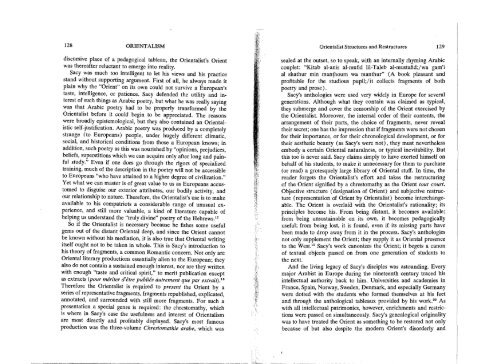Orientalism - autonomous learning
Orientalism - autonomous learning
Orientalism - autonomous learning
You also want an ePaper? Increase the reach of your titles
YUMPU automatically turns print PDFs into web optimized ePapers that Google loves.
128 ORIENTALISM<br />
Orientalist Structures and Restructures 129<br />
discursive place of a pedagogical tableau, the Orientalist's Orient<br />
was thereafter reluctant to emerge into reality.<br />
Sacy was much too intelligent to let his views and his practice<br />
stand without supporting argument. First of all, he always made it<br />
plain why the "Orient" on its own could not survive a European's<br />
taste, intelligence, or patience. Sacy defended the utility and interest<br />
of such things as Arabic poetry, but what he was really saying<br />
was that Arabic poetry had to be properly transformed by the<br />
Orientalist before it could begin to be appreciated. The reasons<br />
were broadly epistemological, but they also contained an Orientalistic<br />
self-justification. Arabic poetry was produced by a completely<br />
strange (to Europeans) people, under hugely different climatic,<br />
social, and historical conditions from those a European knows; in<br />
addition, such poetry as this was nourished by "opinions, prejudices,<br />
beliefs, superstitions which we can acquire only after long and painful<br />
study." Even if one does go through the rigors of specialized<br />
training, much of the description in the poetry will not be accessible<br />
to Europeans "who have attained to a higher degree of civilization."<br />
Yet what we can master is of great value to us as Europeans accustomed<br />
to disguise our exterior attributes, our bodily activity, and<br />
our relationship to nature. Therefore, the Orientalist's use is to make<br />
available to his compatriots a considerable range of unusual experience,<br />
and still more valuable, a kind of literature capable of<br />
helping us understand the "truly divine" poetry of the Hebrews.1 7<br />
So if the Orientalist is necessary because he fishes some useful<br />
gems out of the distant Oriental deep, and since the Orient cannot<br />
be known without his mediation, it is also true that Oriental writing<br />
itself ought not to be taken in whole. This is Sacy's introduction to<br />
his theory of fragments, a common Romantic concern. Not only are<br />
Oriental literary productions essentially alien to the European; they<br />
also do not contain a sustained enough interest, nor are they written<br />
with enough "taste and critical spirit," to merit publication except<br />
as extracts (pour meriter d'etre publies autrement que par extrait).18<br />
Therefore the Orientalist is required to present the Orient by a<br />
series of representative fragments, fragments republished, explicated,<br />
annotated, and surrounded with still more fragments. For such a<br />
presentation a special genre is required: the chrestomathy, which<br />
is where in Sacy's case the usefulness and interest of <strong>Orientalism</strong><br />
are most directly and profitably displayed. Sacy's most famous<br />
production was the three-volume Chrestomathie arabe, which was<br />
sealed at the outset, so to speak, with an internally rhyming Arabic<br />
couplet: "Kitab al-anis al-mufid lil-Taleb al-mustafid;/wa gam'i<br />
al shathur min man\houm wa manthur" (A book pleasant and<br />
profitable for the studious pupil;/it collects fragments of both<br />
poetry and prose) .<br />
Sacy's anthologies were used very widely in Europe for several<br />
generations. Although what they contain was claimed as typical,<br />
they submerge and cover the censorship of the Orient exercised by<br />
the Orientalist. Moreover, the internal order of their contents, the<br />
arrangement of their parts, the choice of fr~gments, never reveal<br />
their secret; one has the impression that if fragments were not chosen<br />
f'or their importance, or for their chronological development, or for<br />
their aesthetic beauty (as Sacy's were not), they must nevertheless<br />
embody a certain Oriental naturalness, or typical inevitability. But<br />
this too is never said. Sacy claims simply to have exerted himself on<br />
behalf of his students, to make it unnecessary for them to purchase<br />
(or read) a grotesquely large library of Oriental stuff. In time, the<br />
reader forgets the Orientalist's effort and takes the restructuring<br />
of the Orient signified by a chrestomathy as the Orient tout court.<br />
Objective structure (designation of Orient) and subjective restructure<br />
(representation of Orient by Orientalist) become interchangeable.<br />
The Orient is overlaid with the Orientalist's rationality; its<br />
principles become his. From being distant, it becomes available;<br />
from being unsustainable on its own, it becomes pedagogically<br />
useful; from being lost, it is found, even if its missing parts have<br />
been made to drop away from it in the process. Sacy's anthologies<br />
not only supplement the Orient; they supply it as Oriental presence<br />
to the West. 19 Sacy's work canonizes the Orient; it begets a canon<br />
of textual objects passed on from one generation of students to<br />
the next.<br />
And the living legacy of Sacy's disciples was astounding. Every<br />
major Arabist in Europe during the nineteenth century traced his<br />
intellectual authority back to him. Universities and academies in<br />
France, Spain, Norway, Sweden, Denmark, and especially Germany<br />
were dotted with the students who formed themselves at his feet<br />
and through the anthological tableaux provided by hiswork.20 As<br />
with all intellectual patrimonies, however, enrichments and restrictions<br />
were passed on simuitaneously. Sacy's genealogical originality<br />
was to have treated the Orient as something to be restored not only<br />
because of but also despite the modern Orient's disorderly and
















